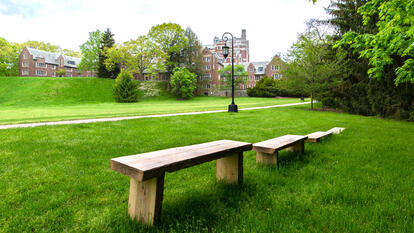Wellesley Student Research Team Investigates How Gases Pass From the Air Into the Ocean

To study how gases like carbon dioxide transfer from the air into the ocean, a team of Wellesley College students, led by assistant professor of chemistry Rachel Stanley, took their research to the largest wind-wave tank in the nation to simulate hurricane conditions.
The group’s two-week research project, funded by a $260,000 grant from the National Science Foundation, and in collaboration with the University of Miami, is underway at the university’s Surge Structure Atmosphere Interaction Facility (SUSTAIN laboratory).
Stanley said the SUSTAIN tank, which measures 75 feet by 20 feet and is filled with seawater, simulates hurricane conditions with winds of up to 110 miles per hour, and gives the researchers the opportunity to study changes in gases during windy, hazardous conditions without actually being exposed to a storm at sea.
“This gives us a picture of the gas exchange process during high winds. Gas transfer is largest during a storm because the wind churns the water which increases the transfer,” said Stanley. “And with carbon dioxide increasing in the atmosphere, it is important to have a better understanding of how gases transfer into the ocean, so scientists predict how climatically important gases transfer into the seas,” said Stanley.
A quarter of the carbon dioxide produced by humans, through actions like burning fuel or using cars, moves from the atmosphere into the ocean. The heat-trapping gas is consistently cited as a key indicator in climate change, and elevated carbon dioxide levels also raise water temperatures and the acidic level of water, Stanley said.
Carbon dioxide levels are tricky to measure and can often fluctuate or be subject to change during measurements due to several variables. Because of this, in this project, the team did not actually analyze for carbon dioxide levels in the water at the SUSTAIN lab. Rather, by looking at the transfers and behaviors of a group of gases known as noble gases—like neon, argon, krypton, and xenon, which are far more stable and unchanging—the group can interpret the data and make estimates about the transfer of carbon dioxide.
As part of their analysis, the team is using a specialized, portable mass spectrometer that was developed by Stanley when she was a researcher at Woods Hole Oceanographic Institute. This was the first use of her technology. The students, Danielle Aldrett ’21, Helene Alt ’19, Lumi Kinjo ’19, and Emily Kopp ’20, all learned how to use the mass spectrometer while doing research with Stanley during the Wellesley Science Center Summer Research Program. Alt and Kinjo will be using data from this experiment as a main component of their senior theses, and Alt will also be presenting her research at the annual American Chemical Society’s national meeting and exposition in Boston next month.



